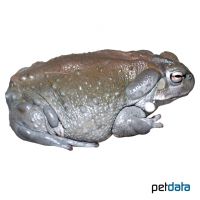Sonoran Desert Toad (Incilius alvarius)
| Sonoran Desert Toad Incilius alvarius | |
|---|---|
| Name | Sonoran Desert Toad |
| Name Lat. | Incilius alvarius |
| Synonym | Bufo alvarius |
| Family | Bufonids |
| Family lat. | Bufonidae |
| Order | Frogs & Toads |
| Order lat. | Anura |
| Origin | SW-USA, NW-Mexico |
| Habitat | Semi-desert, grassland |
| Diet | Live insects |
| Humidity | 40-80 % |
| Behavior | Nocturnal |
| Keeping | Individual |
| Care Level | Moderate |
| Breeding | None reported |
| Housing | Dry terrarium |
| Life Span | 8-10 years |
| Protection | No |
| Metric Units | |
| Size | 11-18 cm |
| Temperature | 23-27 °C |
| Housing Size | 60 x 60 x 50 cm |
| US Units | |
| Size | 4.3"-7" |
| Temperature | 73-81 °F |
| Housing Size | 25" x 25" x 20" |
Distribution and habitat
The range of the crepuscular and nocturnal Colorado toad is in the southwestern United States and northwestern Mexico. There it inhabits dry and semi-arid desert areas as well as grasslands up to a sea level of more than 1,600 m and is always found near waterholes, temporary rain pools or irrigation ditches
Maintenance
For 1 animal, the minimum area of the terrarium is 3,600 cm² with a minimum effective height (measured without substrate) of 40 cm. This corresponds to a base area of e.g. 60 x 60 cm, for 2 animals at least 70 x 60 cm. The terrarium should be placed in a quiet place without sunlight
You need a terrarium with a substrate of at least 20 cm of loose, absorbent, non-rotting substrate such as sand-peat mixture, coconut fibers or sphagnum moss with a drainage and a shallow watering place as large as possible, back and side wall coverings made of e.g. natural cork boards as well as hiding places (stones, leaves, branches) and a planting (e.g. Tradescantia, Ficus, Scindapsus, ferns). Potted plants that can be easily removed for cleaning are advantageous. The substrate should be finely sprayed with water occasionally
| Temp. day: 23-27 °C | Temp. night: 18-20 °C | Humidity: 40-80 |
The lighting duration must be 10-14 hours depending on the season. Ideal are daylight fluorescent tubes with low UV content.a winter rest of 2-4 months at about 10 ° C should be observed
Diet
According to their size, the food supply consists of live insects, such as grasshoppers, crickets, house crickets, etc., or a ready-made food for insectivores, supplemented with arachnids, worms and snails. Commercially available dog and cat food is also accepted. Food should be offered to adult animals 1-2 times a week, young animals must be fed daily. It is important to add minerals and vitamins regularly (e.g. by dusting the feed animals). The quality of the feed animals can be enhanced by giving overripe fruit and honey water. A regular and varied diet promotes health and prevents deficiency symptoms.
Reproduction and breeding
Both sexes are usually dark olive green in color. Males remain significantly smaller than females.
Sexual maturity is reached at 3 years of age at the earliest. When weather conditions are favorable, the female ready to spawn is taken in the mating grip (amplexus) by the male and it lays several thousand eggs. After 2-12 days the larvae (tadpoles) hatch. After another 30-40 days the transformation (metamorphosis) is completed and the young toads leave the water.
Life expectancy can be over 10 years.
Obligation to report
Within two weeks after purchase, you must notify the district administrative authority of your place of residence in accordance with § 25 (1) of the Animal Welfare Act. Your pet store will be happy to provide you with further information.
Important
During the dry season it buries itself in the sand or uses abandoned rodent burrows as shelter. To protect itself against dehydration, it covers itself with a mucilaginous secretion.
The skin secretion contains psychoactive (hallucinogenic) substances. The venom is located in the ear gland bulges and on the upper side of the calves. Caution is therefore advised when handling the animals. Clean hands thoroughly after touching.
The terrarium must have good ventilation without drafts and meet the species-specific needs. Measuring devices such as thermometers, hygrometers, etc. are necessary. The lighting has to correspond to the species-specific day-night rhythm and has to be placed in such a way that the animals cannot injure themselves. The terrarium should be locked in such a way that neither unauthorized persons can open it nor the animals can escape. Special attention must be paid to thorough hygiene and impurities must be removed regularly.
Further literature can be found in your pet store.
References
Text: Serena Werle; Image: petdata
Source: VDA & DGHT (2006): Haltungsrichtlinien für die Haltung von Anuren; ENGELMANN (2006): Zootierhaltung - Tiere in menschlicher Obhut: Reptilien und Amphibien, Harri Deutsch Verlag
- Gemäß § 21 Abs. 5 Tierschutzgesetz idgF
